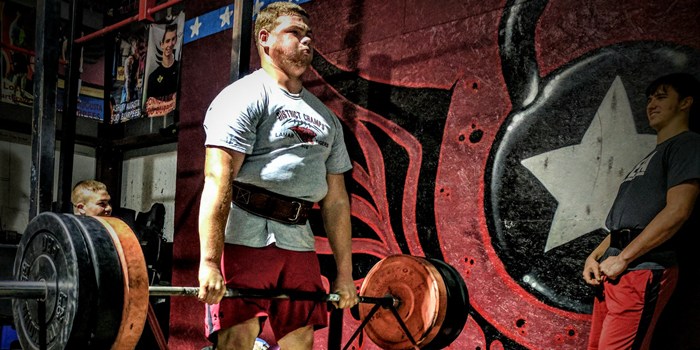
The Swing Block Method is one of the greatest ways to gain strength, and now we're showing high school coaches how to apply it in their weight rooms.
In my previous article explaining how the Swing Block Method works, I discussed using this method for upper-level athletes and made it clear that it wasn't appropriate for beginners. Since publication, I've received numerous emails and messages from high school and collegiate coaches with various questions, which has made me realize this new method needs to be made available in a way that it can be effectively used in a school setting where there is little time and a great number of athletes to cycle through.
RECENT: The Swing Block Method
What is often difficult for a high school coach is that the ability level in the weight room varies greatly from one student to the next. You can have a freshman who has never touched a barbell sitting next to a senior who has a training age of four years that's more skilled in the intended movements. In a perfect world each student would have their own program based on their ability and training age, but let's be honest — this isn't a perfect world, and when you have 40 minutes and 60 kids to cycle through, you're going to be lucky to even get them a pump on most programs. You have championships to win and to do that you need to maximize your kids' strength without killing them for the game Friday. This program is very easy to monitor progress with lots of testing so you can constantly watch to make sure your athletes are improving without any guesswork.
So here you go. The greatest strength gains your team has ever had are coming.
We are taking into account that your first few weeks will be during the summer when you can have more focus and time in the weight room and are not constrained to school hours. During these first few weeks, we will be getting the kids ready for the big weights, but you can't jump right into them. Consider this block to be priming the pump of greatness. We know that max effort training is proven to be the best method of strength gains, but we also must take an account that during a summer off, an athlete's nervous system isn't ready for maximum effort. During the first three-week block we will only care about movement patterns and priming the nervous system. Without proper movement patterns you will not get the most out of your athletes, no matter the program and no matter how experienced in training they are. A summer off will deteriorate their movement patterns. If you're picking up on this program after the season has already started, skip the first block and get right to the real work.
For our training, we will be focusing on compound movements that bring up the most muscle groups at once, plus jumping and the hang clean.
In the original Swing Block Method, we complete most of our movements with five sets of varying reps. Because of the time constraints of running so many kids through a workout, we will be basing all of the reps and percentages on Prilepin’s chart. If you're not familiar with this training tool, you can find a great deal of information here. What this is going to do for you is allow you as a coach to get maximum results from your athlete's strength training with lower volume. This will allow you to get through your workouts faster but with maximum results. Using percentages based solely on Prilepin's Chart has another great benefit for you as a coach: the recovery from workout to workout will be faster. It isn't max effort work that beats your players down; it's high volume work. The more reps your players do, the greater the damage to the muscle fibers, the sorer they are, and the more time they need to recover. If they need a lot of recovery time from the weight room it can hold back their conditioning and practice. The lower the volume, the faster they will recover. We are focusing on their strength and explosiveness in the weight room; the conditioning happens under your guidance on the practice field and this will allow them to be 100% for you.
MORE: Utilizing Prilepin’s Chart
We want to focus on compound movements because in a school setting you will have little time to focus on different muscle groups, and compound movements will work many muscle groups at the same time. Compound movements also follow the body's natural movement patterns, unlike machines that create artificial movements while not accounting for the force-velocity curve. The body is made up of lever systems and we want to strengthen those levers in all positions, which is exactly why we will be using bands in some of our blocks.
You'll notice there are zero power cleans in this program, which seems to be a staple of high school training programs. As an Olympic weightlifting coach, I understand the movement better than most, so I'll explain why we are focusing on the hang clean only. When doing the power clean, the first pull (getting the bar from the ground to above your knees) is simply to set up the rest of the movement. It makes no difference how fast the first pull is; it simply is there to get the bar in the position for the rest of the work. Other weightlifting coaches may disagree with that statement and that's their incorrect opinion because I'm right. The only way the bar speed from the bottom would matter is if your kids are performing muscle cleans because they have bad form. If that's the case then you're wasting your time anyway on that movement and it needs to be thrown out the damn window.
Drilling the power clean, unless you are a specialist in Olympic Weightlifting, is a waste of time, because the explosive power happens when you actually start the second and third pull with the bar to get under it — power clean or full clean alike. If you watch Olympic lifters on YouTube you will notice the first pull is often very slow. So for time management reasons, we will only focus on the hang clean since this is the only portion of the movement that matters in terms of direct transfer to game day. Plus, it saves you time having to worry about teaching an aspect of a movement you don't need anyway. Your time in the weight room is unbelievably valuable to your program, so if it isn't going to help make your kids champions we don't want to waste time on it. Also, the clean deadlift and the traditional deadlift are different movements with different starting and pulling positions, so this helps you to not need to worry about teaching different techniques. Again, we are intending to maximize the results of your valuable time under the bar.
For this program, I'm going to prescribe something that's far outside the box from other programs. At the end of every squat except when doing max effort work, perform a toe raise at the end of the movement. Make sure there is a pause between the end of the squat movement and the toe raise. We're doing this to take advantage of the position and get in calf work as well. Having limited time, this is a great way to work that muscle group in and it'll also help to increase power production off the line, sprinting, and in jumping. When maxing out, leave it out. The athletes need to focus on the lift, not anything extra. If they create a habit of it and do it anyway, great, but it isn't necessary.
When performing the strict press, after the first rep have the athletes go no lower than the chin. Below that can open the rotator cuff to injury. While not likely, having a star player or any other player injured can be detrimental to a season. There isn't going to be any difference in strength or force development by bringing the bar down two more inches to the chest. Better safe than sorry. We always want to minimize any risk of any injury.
We are going to jump, a lot. Jumping is the greatest way to increase and measure explosive power. If your athlete has a 30-inch box jump at the start of the season and a 58-inch box jump at the end of the season, you have a way to accurately measure their increase in explosive power without high dollar equipment.
Accommodating resistance is a very large part of this program. Accommodating resistance is the use of chains and bands to increase the force-velocity curve and add over-speed eccentrics. The body is completely made up of lever systems. When you're at your lowest on the squat, your lever system is at its weakest. That's why you see “bros" in the gym doing shallow squats because staying that high, the lever system is at its strongest. It strokes their ego without the need of doing any real work. It's harder to use full range of motion so they simply won't do so, and instead, happily let their knees and gains pay the price without getting full results. Remember, partial reps mean partial results.
If you have time left in your lifting sessions for accessory work, focus on abdominal work and increase the core strength. We will be performing good mornings often to strengthen and protect the back. When you find the time, be sure to fit in core movements to balance out the athlete's body.
Conditioning will not be addressed in this writing. We will assume that since this is directed to sport coaches that the athletes will get all the conditioning they need during practice.
With the understanding that you have to get these kids in and out fast with the maximum results possible, this modification of the program is designed for a class setting that only has a very limited time frame to maximize results.
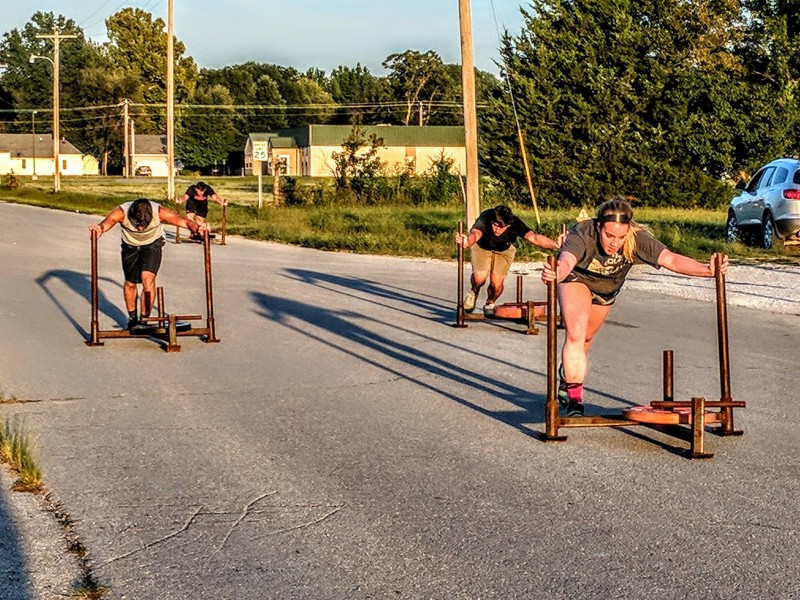
In the original Swing Block Method, there are deload weeks. Since this is directed to seasonal athletes we will not include deloading. They deload over the summer, after the season, during school breaks, and their bodies are young enough that they can recover week to week without breaks, unlike adults.
When we are in the five-rep range we are building a combination of strength, speed, and mass. It isn't bodybuilding mass, but there will still be an increase of lean mass by means of the sarcoplasmic hypertrophy taking place. The majority of the benefits from this range, however, will be myofibril hypertrophy. When doing these movements you want the bar to move as fast as possible to build speed strength.
Within the three-rep range we are focusing strictly on increasing strength and making myofibril hypertrophy take place. This is heavy lifting — we want the body to feel the stress of the weight and respond accordingly. When dealing with kids, you have to remember that testosterone is high and they will gladly throw form out the window if they think they can get more weight up. Watch them closely, but we need to move as much weight as possible while being as safe as possible. Remember, the body can only adapt to the stimulus placed on it.
The original Swing Block Method also has many sarcoplasmic hypertrophy weeks after each block. Sarcoplasmic hypertrophy is very high rep, low weight training. It's great for building both mass and increasing tendon health. The drawback to this type of training is that it can make the muscles very sore. We are avoiding this because we don't want your players running up and down the court or field with muscles that are sore and can't operate at 100%. If you're out of season, this is great for your program and you should place these between each block. For more information on how to structure the sarcoplasmic hypertrophy week, refer to the original Swing Block Method.
This program comes together from over 15 years experience in Olympic weightlifting, powerlifting, MMA, CrossFit, and bodybuilding, in which all of these different sports have come together. This method has been created by Jeremy Augusta, owner of Barton County Strength Club, and with it, members have achieved amazing success in strength sports. After publication of the Swing Block Method on elitefts, emails came non-stop from coaches around the country asking how to implement the program into their school. Here is the answer. The below program will give your team the greatest strength results it has ever seen.
The Swing Block Method for High School Coaches
Week 1
During this week we are focusing on how to move correctly. Relatively light weight will be used. Since we don't have any rep max or 1RM numbers, we are not specifying any specific percentage to be used. We are going to call it a 10-rep max. During this number, we can focus on form and each kid should be under the bar enough that the coaching staff can see and correct any movement patterns.
Monday
- Front Squat — 3x10RM
- Back Squat — 3x10RM
- Box Jump Max
Tuesday
- Bench Press — 3x10RM
- Strict Press — 3x10RM
- Pendlay Row — 3x10RM
This is the perfect time to make sure that the shoulders are set properly for the bench. In my experience, it is hard to get student-athletes in the habit of correct form, especially on the bench. With the weight being so light, even though the reps are high, this should go very fast so you can afford yourself the time to set sold movement patterns.
Wednesday
- Deadlift — 3x10RM
- Seated Good Morning — 3x10RM
- Seated Box Jumps — 20 Reps
Thursday
- Biceps
- Triceps
- Hang Clean — 3x12RM
- Shrugs and Neck Work
Before we move on, I want to explain the reasoning for the arm work. This is indeed intended to be “curls for the girls”. Here's why. When a teenager looks in the mirror, he's going to flex his arms. We know this — hell we still do this. While biceps size is never going to be directly related to performance, it is directly related to confidence. The bigger your athletes' biceps are, the more confidence they will have. A more confident player is a more aggressive player. Do you favorite arm work here and make sure it's high rep. This isn't strength training; it's training for sarcoplasmic hypertrophy.
Friday
Every Friday we will be doing a five-rep max on back squat. It's not enough volume to slow down the athletes. On the contrary, it'll not only make them stronger but will induce post-activation potentiation so they perform their best later in the evening for game night.
- Back Squat — 5RM
- Box Jump — 20 Reps
Week 2
Monday
- Front Squat — 3x10RM
- Back Squat — 3x10RM
- 20 High Box Step-Ups
Tuesday
- Bench Press — 3x10RM
- Strict Press — 3x10RM
- Pendlay Row — 3x10 Reps
Wednesday
- Deadlift — 3x10RM
- Standing Good Morning — 3x10RM
- Seated Box Jumps — 20 Reps
Thursday
- Biceps
- Triceps
- Hang Clean — 3x10RM
- Shrugs and Neck Work
Friday
- Back Squat — 5RM
- Box Jumps — 20 Reps
Week 3
This is the last week of preparing the body for the heavy work and focusing on learning movement patterns. Please remember to always pay attention to correct movement patterns regardless of where you are in the program.
Monday
- Front Squat — 3x8RM
- Back Squat — 3x8RM
- Box Jumps — 20 Reps
Tuesday
- Bench Press — 3x8RM
- Strict Press — 3x8RM
- Pendlay Row
Wednesday
- Deadlift — 3x8RM
- Seated Good Morning — 3x8RM
- Seated Box Jumps — 20 Reps
Thursday
- Biceps
- Triceps
- Hang Clean — 3x8RM
- Shrugs and Neck Work
Friday
- Back Squat — 5RM
- Box Jumps — 20 Reps
Week 4
New Block
This week we are going forward with the heavier weights and will start the max effort work. After three weeks of training the movements, the athletes should be good to perform them under load.
Monday
- Front Squat — 5x5 to find 5RM
We want each set to be a working set. By the last one, the athletes should have a five-rep max in all of the movements.
- Back Squat — 5x5 to find 5RM
- Box Jump Max
Tuesday
- Bench Press — 5x5 to find 5RM
- Strict Press — 5x5 to find 5RM
- Pendlay Row — 5x5 to find 5RM
Wednesday
- Deadlift — 5x5 to find 5RM
- Seated Good Morning — 5x5 to find 5RM
- Seated Box Jumps — 20 Reps
Thursday
- Biceps
- Triceps
- Hang Clean — 5x5 to find 5RM
- Shrugs and Neck Work
Friday
- Back Squat — 5RM
- Box Jumps — 20 Reps
Week 5
Now that we have our 5RM numbers we will be performing our movements based on a percentage of the numbers from last week.
Monday
- Front Squat — 3x5 with 85% of 5RM
- Back Squat — 3x5 with 85% of 5RM
- Box Jumps — 20 Reps
Tuesday
- Bench Press — 3x5 with 85% of 5RM
- Strict Press — 3x5 with 85% of 5RM
- Pendlay Row — 3x5 with 85% of 5RM
Wednesday
- Deadlift — 3x5 with 85% of 5RM
- Seated Good Morning — 3x5 with 65% of 5RM
- Box Jumps — 20 Reps
Thursday
- Biceps
- Triceps
- Hang Clean — 3x5 with 85% of 5RM
- Shrugs and Neck Work
Friday
- Back Squat — 5RM
- Box Jumps — 20 Reps
Week 6
Monday
- Front Squat — 3x5 with 85% of 5RM with accommodating resistance. If accommodating resistance isn't possible, go to 90% of 5RM.
- Low Box Back Squat — 3x5 with 85% of 5RM with accommodating resistance. If accommodating resistance isn't possible, go to 90% of 5RM.
- Box Jumps — 20 Reps
Tuesday
- Bench Press— 3x5 with 85% of 5RM with accommodating resistance. If accommodating resistance isn't possible, go to 90% of 5RM.
- Strict Press— 3x5 with 85% of 5RM with accommodating resistance. If accommodating resistance isn't possible, go to 90% of 5RM.
- Pendlay Row— 3x5 with 85% of 5RM with accommodating resistance. If accommodating resistance isn't possible, go to 90% of 5RM.
Wednesday
- Deadlift — 3x5 with 85% of 5RM with accommodating resistance. If accommodating resistance isn't possible, go to 90% of 5RM.
- Seated Good Morning — 3x5 with 65% of 5RM
- Seated Box Jumps — 20 Reps
Thursday
- Biceps
- Triceps
- Hang Clean — 3x5 with 90% of 5RM
- Shrugs and Neck Work
Friday
- Back Squat — 5RM
- Box Jumps — 20 Reps
Week 7
Monday
- Front Squat — 3x5 with 93% of 5RM
- Back Squat — 3x5 with 93% of 5RM
- Box Jumps — 20 Reps
Tuesday
- Bench Press — 3x5 with 93% of 5RM
- Strict Press — 3x5 with 93% of 5RM
- Pendlay Row — 3x5 with 93% of 5RM
Wednesday
- Deadlift — 3x5 with 93% of 5RM
- Seated Good Morning — 3x5 with 93% of 5RM
- Box Jumps — 20 Reps
Thursday
- Biceps
- Triceps
- Hang Clean — 3x5 with 93% of 5RM
- Shrugs and Neck Work
Friday
- Back Squat — 5RM
- Box Jumps — 20 Reps
Week 8
New Block
This three-week block is focusing on having greater intensity and slightly less volume. While we may be doing a few less reps, the weight being used should be significantly higher from the original 5RM. What will not change is the Friday 5RM on the back squat. We want to constantly be pushing that number higher and higher.
Monday
We want each set to be a working set. By the last one, the athletes should have a 3RM in all of the movements.
- Front Squat — 5x3 to find 3RM
- Back Squat — 5x3 to find 3RM
- Box Jump Max
Tuesday
- Bench Press — 5x3 to find 3RM
- Strict Press — 5x3 to find 3RM
- Pendlay Row — 5x3 to find 3RM
Wednesday
- Deadlift — 5x3 to find 3RM
- Seated Good Morning — 5x3 to find 3RM
- Box Jumps — 20 Reps
Thursday
- Biceps
- Triceps
- Hang Clean — 5x3 to find 3RM
- Shrugs and Neck Work
Friday
- Back Squat — 5RM
- Box Jumps — 20 Reps
Week 9
Monday
- Front Squat — 5x3 with 85% of 3RM
- Back Squat — 5x3 with 85% of 3RM
- Box Jumps — 20 Reps
Tuesday
- Bench Press — 5x3 with 85% of 3RM
- Strict Press — 5x3 with 85% of 3RM
- Pendlay Row — 5x3 with 85% of 3RM
Wednesday
- Deadlift — 5x3 with 85% of 3RM
- Seated Good Morning — 5x3 with 60% of 3RM
- Seated Box Jumps — 20 Reps
Thursday
- Biceps
- Triceps
- Hang Clean — 5x3 with 85% of 3RM
- Shrugs and Neck Work
Friday
- Back Squat — 5RM
- Box Jumps — 20 Reps
Week 10
If accommodating resistance isn't an option, use 90% of 3RM in its place.
Monday
- Front Squat — 5x3 with 80% of 3RM with accommodating resistance
- Low Box Back Squat — 5x3 with 80% of 3RM with accommodating resistance
- Box Jumps — 20 Reps
Tuesday
- Bench Press — 5x3 with 80% of 3RM with accommodating resistance
- Strict Press — 5x3 with 80% of 3RM with accommodating resistance
- Pendlay Row — 5x3 with 90% of 3RM
Wednesday
- Deadlift — 5x3 with 80% of 3RM with accommodating resistance
- Seated Good Morning — 5x3 with 80% of 3RM with accommodating resistance
- Box Jumps — 20 Reps
Thursday
- Biceps
- Triceps
- Hang Clean — 5x3 with 80% of 3RM with accommodating resistance
- Shrugs and Neck Work
Friday
- Back Squat — 5RM
- Box Jumps — 20 Reps
Week 11
Monday
- Front Squat — 5x3 with 95% of 3RM
- Back Squat — 5x3 with 95% of 3RM
- Box Jumps — 20 Reps
Tuesday
- Bench Press — 5x3 with 95% of 3RM
- Strict Press — 5x3 with 95% of 3RM
- Pendlay Row — 5x3 with 95% of 3RM
Wednesday
- Deadlift — 5x3 with 95% of 3RM
- Seated Good Morning — 5x3 with 70% of 3RM
- Seated Box Jumps — 20 Reps
Thursday
- Biceps
- Triceps
- Hang Clean — 5x3 with 95% of 3RM
- Shrugs and Neck Work
Friday
- Back Squat — 5RM
- Box Jumps — 20 Reps
Week 12
New Block
This week we will be performing our 1RM testing. Make sure your athletes warm up very well for this. It's very easy to recover from a 1RM, so this is a week that would be good to do a lot more accessory work or longer conditioning on the field.
Monday
- Front Squat — 1RM
- Back Squat — 1RM
- Box Jump Max
Tuesday
- Bench Press — 1RM
- Strict Press — 1RM
- Pendlay Row — 1RM
Wednesday
- Deadlift — 1RM
- Seated Good Morning — 5x3 with 75%
We don't need a 1RM on this movement, so we increased the weight five percent from last week. We don't want the kids bending over with maximum loads on their back in this manner.
- Box Jumps — 20 Reps
Thursday
- Biceps
- Triceps
- Hang Clean — 1RM
- Shrugs and Neck Work
Friday
- Back Squat — 5RM
- Box Jumps — 20 Reps
Week 13
This week is true max effort work. We will be performing each movement for eight reps at 90% of max effort weight.
Monday
- Front Squat — 8 Reps with 90% of 1RM
- Back Squat — 8 Reps with 90% of 1RM
- Box Jumps — 20 Reps
Tuesday
- Bench Press — 8 Reps with 90% of 1RM
- Push Press — 8 Reps with 90% of 1RM
- Pendlay Row — 8 Reps with 90% of 1RM
Wednesday
- Deadlift — 8 Reps with 90% of 1RM
- Seated Good Morning — 5x3 with 80% of 3RM
- Seated Box Jumps — 20 Reps
Thursday
- Biceps
- Triceps
- Hang Clean — 8 Reps with 90% of 1RM
- Shrugs and Neck Work
Friday
- Back Squat — 5RM
- Box Jumps — 20 Reps
Week 14
This week is true max effort work. We will be performing each movement for eights rep with 95% of max effort weight.
Monday
- Front Squat — 8 Reps with 95% of 1RM
- Back Squat — 8 Reps with 95% of 1RM
- Box Jumps — 20 Reps
Tuesday
- Bench Press — 8 Reps with 95% of 1RM
- Push Press — 8 Reps with 95% of 1RM
- Pendlay Row — 8 Reps with 95% of 1RM
Wednesday
- Deadlift — 8 Reps with 95% of 1RM
- Seated Good Morning — 5x3 with 80% of 3RM
- Box Jumps — 20 Reps
Thursday
- Biceps
- Triceps
- Hang Clean — 8 Reps with 95% of 1RM
- Shrugs and Neck Work
Friday
- Back Squat — 5RM
- Box Jumps — 20 Reps
Week 15
This week is true max effort work. We will be performing each movement for eight reps with 100% of max effort weight. If after the first six reps your athletes are feeling really strong, let them take two attempts at a 1RM.
Monday
- Front Squat — 8 Reps with 100% of 1RM
- Back Squat — 8 Reps with 100% of 1RM
- Box Jumps — 20 Reps
Tuesday
- Bench Press — 8 Reps with 100% of 1RM
- Push Press — 8 Reps with 100% of 1RM
- Pendlay Row — 8 Reps with 100% of 1RM
Wednesday
- Deadlift — 8 Reps with 100% of 1RM
- Seated Good Morning — 5x3 with 80% of 3RM
- Seated Box Jumps — 20 Reps
Thursday
- Biceps
- Triceps
- Hang Clean — 8 Reps with 100% of 1RM
- Shrugs and Neck Work
Friday
- Back Squat — 5RM
- Box Jumps — 20 Reps
At this point, the pattern starts back at the beginning and repeats indefinitely.
Images courtesy of Barton County Strength Club
Jeremy Augusta is the owner of Barton County Strength Club which is known for their extremely successful competitive strength team. Jeremy is a USAW L2 coach with 15 years fitness experience with background in MMA, powerlifting, Olympic Weightlifting, and bodybuilding, all which come together in his programming.









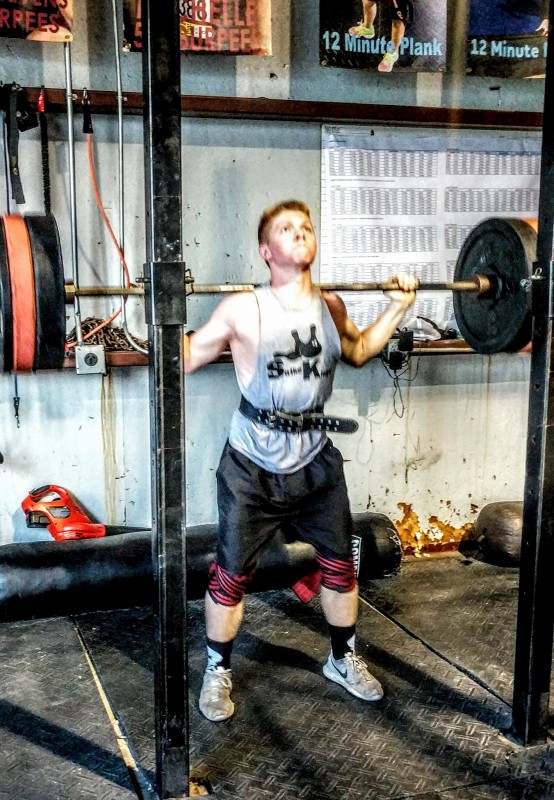
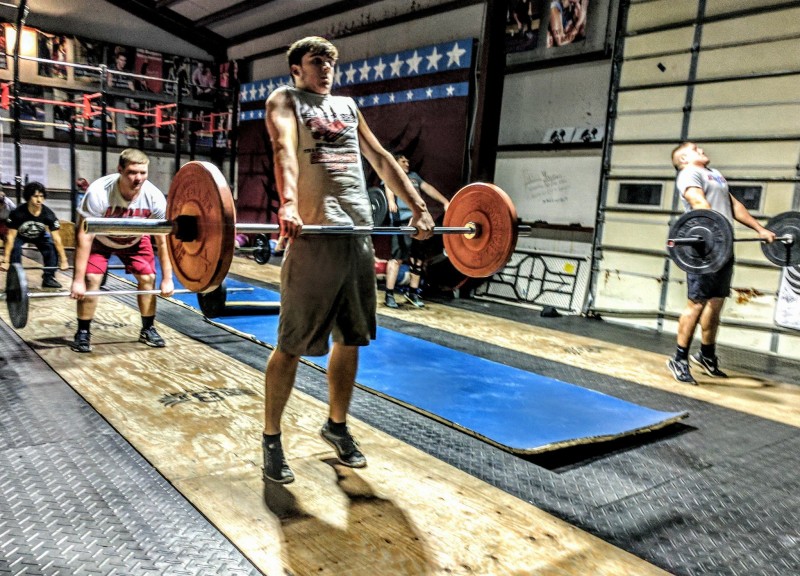
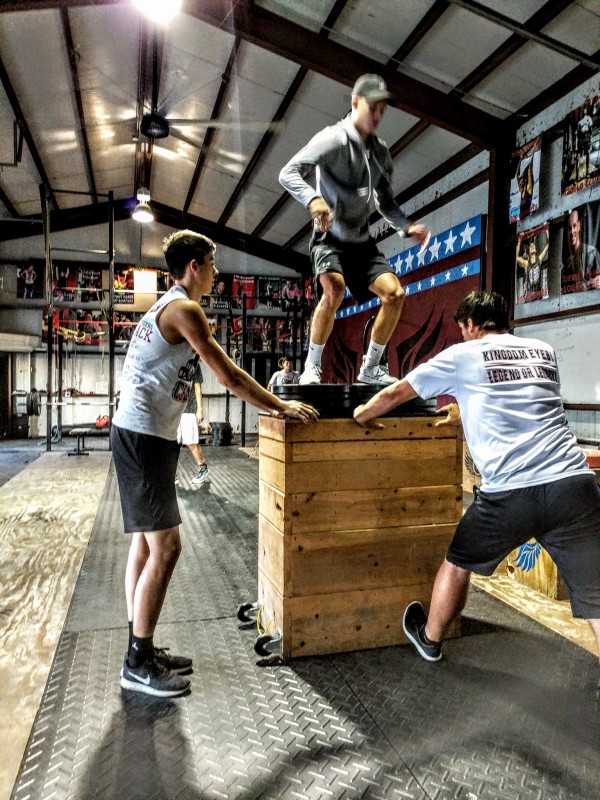

If we use Monday, Week 15 as an example. The kids are doing front and back squats at 90%. If they are goofing off and being kids they may run out of time to do the jumps that are programmed. If the jumps came first, and they ran out of time before they finished they wouldn't have the opportunity to complete all their strength work.
Again, the goal of this the way it is written is to maximize strength building in the small window of time.